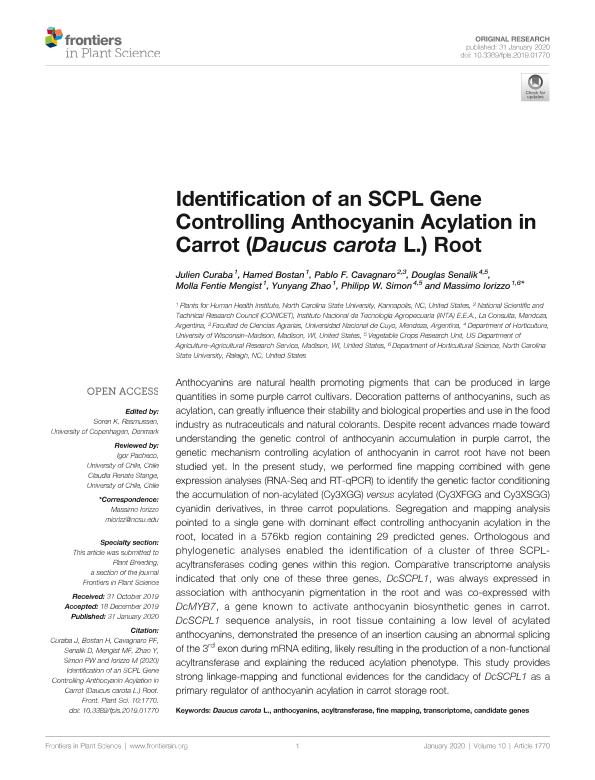Mostrar el registro sencillo del ítem
dc.contributor.author
Curaba, Julien
dc.contributor.author
Bostan, Hamed
dc.contributor.author
Cavagnaro, Pablo Federico

dc.contributor.author
Senalik, Douglas A.

dc.contributor.author
Mengist, Molla Fentie
dc.contributor.author
Zhao, Yunyang
dc.contributor.author
Simon, Philipp W.
dc.contributor.author
Iorizzo, Massimo

dc.date.available
2022-10-28T17:55:48Z
dc.date.issued
2019-06
dc.identifier.citation
Curaba, Julien; Bostan, Hamed; Cavagnaro, Pablo Federico; Senalik, Douglas A.; Mengist, Molla Fentie; et al.; Identification of an SCPL gene controlling anthocyanin acylation in carrot (Daucus carota L.) root; Frontiers Media; Frontiers in Plant Science; 10; 6-2019
dc.identifier.issn
1664-462X
dc.identifier.uri
http://hdl.handle.net/11336/175421
dc.description.abstract
Anthocyanins are natural health promoting pigments that can be produced in large quantities in some purple carrot cultivars. Decoration patterns of anthocyanins, such as acylation, can greatly influence their stability and biological properties and use in the food industry as nutraceuticals and natural colorants. Despite recent advances made toward understanding the genetic control of anthocyanin accumulation in purple carrot, the genetic mechanism controlling acylation of anthocyanin in carrot root have not been studied yet. In the present study, we performed fine mapping combined with gene expression analyses (RNA-Seq and RT-qPCR) to identify the genetic factor conditioning the accumulation of non-acylated (Cy3XGG) versus acylated (Cy3XFGG and Cy3XSGG) cyanidin derivatives, in three carrot populations. Segregation and mapping analysis pointed to a single gene with dominant effect controlling anthocyanin acylation in the root, located in a 576kb region containing 29 predicted genes. Orthologous and phylogenetic analyses enabled the identification of a cluster of three SCPL-acyltransferases coding genes within this region. Comparative transcriptome analysis indicated that only one of these three genes, DcSCPL1, was always expressed in association with anthocyanin pigmentation in the root and was co-expressed with DcMYB7, a gene known to activate anthocyanin biosynthetic genes in carrot. DcSCPL1 sequence analysis, in root tissue containing a low level of acylated anthocyanins, demonstrated the presence of an insertion causing an abnormal splicing of the 3rd exon during mRNA editing, likely resulting in the production of a non-functional acyltransferase and explaining the reduced acylation phenotype. This study provides strong linkage-mapping and functional evidences for the candidacy of DcSCPL1 as a primary regulator of anthocyanin acylation in carrot storage root.
dc.format
application/pdf
dc.language.iso
eng
dc.publisher
Frontiers Media

dc.rights
info:eu-repo/semantics/openAccess
dc.rights.uri
https://creativecommons.org/licenses/by/2.5/ar/
dc.subject
ACYLTRANSFERASE
dc.subject
ANTHOCYANINS
dc.subject
CANDIDATE GENES
dc.subject
DAUCUS CAROTAL
dc.subject
FINE MAPPING
dc.subject
TRANSCRIPTOME
dc.subject.classification
Horticultura, Viticultura

dc.subject.classification
Agricultura, Silvicultura y Pesca

dc.subject.classification
CIENCIAS AGRÍCOLAS

dc.subject.classification
Bioquímica y Biología Molecular

dc.subject.classification
Ciencias Biológicas

dc.subject.classification
CIENCIAS NATURALES Y EXACTAS

dc.title
Identification of an SCPL gene controlling anthocyanin acylation in carrot (Daucus carota L.) root
dc.type
info:eu-repo/semantics/article
dc.type
info:ar-repo/semantics/artículo
dc.type
info:eu-repo/semantics/publishedVersion
dc.date.updated
2022-10-25T14:40:51Z
dc.journal.volume
10
dc.journal.pais
Suiza

dc.journal.ciudad
Lausanne
dc.description.fil
Fil: Curaba, Julien. North Carolina State University. Department Of Food, Bioprocessing And Nutrition Sciences. Plants For Human Health Institute.; Estados Unidos
dc.description.fil
Fil: Bostan, Hamed. North Carolina State University. Department Of Food, Bioprocessing And Nutrition Sciences. Plants For Human Health Institute.; Estados Unidos
dc.description.fil
Fil: Cavagnaro, Pablo Federico. Consejo Nacional de Investigaciones Científicas y Técnicas; Argentina. Instituto Nacional de Tecnología Agropecuaria. Centro Regional Mendoza-San Juan. Estación Experimental Agropecuaria La Consulta; Argentina. Universidad Nacional de Cuyo. Facultad de Ciencias Agrarias. Departamento de Producción Agropecuaria. Cátedra de Horticultura y Floricultura; Argentina
dc.description.fil
Fil: Senalik, Douglas A.. United States Department of Agriculture. Agricultural Research Service; Argentina
dc.description.fil
Fil: Mengist, Molla Fentie. North Carolina State University. Department Of Food, Bioprocessing And Nutrition Sciences. Plants For Human Health Institute.; Estados Unidos
dc.description.fil
Fil: Zhao, Yunyang. North Carolina State University. Department Of Food, Bioprocessing And Nutrition Sciences. Plants For Human Health Institute.; Estados Unidos
dc.description.fil
Fil: Simon, Philipp W.. United States Department of Agriculture. Agricultural Research Service; Argentina
dc.description.fil
Fil: Iorizzo, Massimo. North Carolina State University. Department Of Food, Bioprocessing And Nutrition Sciences. Plants For Human Health Institute.; Estados Unidos
dc.journal.title
Frontiers in Plant Science
dc.relation.alternativeid
info:eu-repo/semantics/altIdentifier/url/https://www.frontiersin.org/articles/10.3389/fpls.2019.01770/full
dc.relation.alternativeid
info:eu-repo/semantics/altIdentifier/doi/http://dx.doi.org/10.3389/fpls.2019.01770
Archivos asociados
